Fledgeling
It’s been very quiet round these parts. Our prolific junior correspondent has flown the nest. You’ll find him over at HampshireBirder’s Blog.
It’s been very quiet round these parts. Our prolific junior correspondent has flown the nest. You’ll find him over at HampshireBirder’s Blog.
Birds
Common Ostrich
Great White Pelican
Pink-backed Pelican
Little Grebe
Great Cormorant
Cattle Egret
Madagascar Squacco Heron
Great Egret
Grey Heron
Black-headed Heron
White stork
Yellow-billed stork
Saddle-billed Stork
Marabou Stork
Sacred Ibis
Hadada Ibis
Glossy Ibis
African Spoonbill
Greater Flamingo
Lesser Flamingo
Egyptian Goose
Cape Teal
Black Kite
Black-shouldered Kite
Secretary Bird
African Fish Eagle
Hooded Vulture
White-backed Vulture
Ruppell’s Griffon Vulture
Lappet-faced Vulture
Black-chested Snake Eagle
Dark Chanting-Goshawk
Gabar Goshawk
Shikra
Augur Buzzard
Common Buzzard
Tawny Eagle
African Hawk-Eagle
Bateleur Eagle
Martial Eagle
Grey Kestrel
Pygmy Falcon
Helmeted Guineafowl
Red-necked Spurfowl
Black Crake
Red-knobbed Coot
Grey Crowned Crane
Kori Bustard
Black-winged Stilt
Collard Pratincole
Blacksmith Lapwing (Blacksmith Plover)
Crowned Lapwing (Crowned Plover)
Kittlitz’s Plover
Chestnut-banded Plover
Yellow-throated Sandgrouse
Olive Pigeon
Feral Pigeon
Ring-necked Dove
African Mourning Dove
Fischer’s Lovebird
Hartlaub’s Turaco
White-browed Coucal
Verreaux’s Eagle-Owl
Little Swift
Eurasian Swift
Grey-headed Kingfisher
White-fronted Bee-eater
Little Bee-eater
Lilac-breasted Roller
African Hoopoe
Yellow-billed Hornbill
Red-billed hornbill
African Grey Hornbill
Cardinal Woodpecker
Red-rumped Swallow
African Pied Wagtail
76 species seen
Grassland Pipit
Common Bulbul
Stonechat
Spotted Mourning Thrush
White-eyed Slaty Flycatcher
Silverbird
Malachite Sunbird
Variable Sunbird
Common Fiscal
Long-tailed Fiscal
Grey-backed Fiscal
Northern White-crowned Shrike
Pied Crow
White-naped Raven
Superb Starling
Hildebrandt’s Starling
Wattled Starling
Rufous Sparrow
House Sparrow
Grey-headed Sparrow
White-browed Sparrow-Weaver
Rufous-tailed Weaver
Grey-capped Social-Weaver
White-headed Buffalo Weaver
Red-billed Buffalo Weaver
Black-headed Weaver
Lesser Masked Weaver
Vitelline Masked Weaver
Red-billed Quelea
Cardinal Quelea
African Golden-breasted Bunting
31 species
The Zebra is a wild member of the horse family that can be found throughout sub-Saharan Africa. There are three species of Zebra – the Common or Plains Zebra that is found all over Eastern and Southern Africa. The Mountain Zebra that is separated into two races, the Cape Mountain Zebra and the Hartmann’s Mountain Zebra. Finally the Grevy’s Zebra is the largest and rarest of Zebras and is found in northern Kenya and southern Ethiopia. Zebras are large animals and often overcome attacks from Lions. When being chased by Lions the stallion goes to the back of the herd and violently kicks out behind him. This method often deters Lions, as they cannot risk injury or even death. It is also believed that the Zebras stripes make it harder for Lions to see them, as Lions are partially colour-blind.
Common or Plains Zebra
The most common of the Zebra family that has the widest range of the three species. It is split into three different races that are shown below.
Grant’s Zebra: southern Sudan, Kenya, Tanzania, Zambia and northern Zimbabwe.
Chapman’s Zebra: Namibia, Angola and western South Africa.
Burchell’s Zebra: South Africa, Botswana, Swaziland, Zimbabwe and Mozambique.
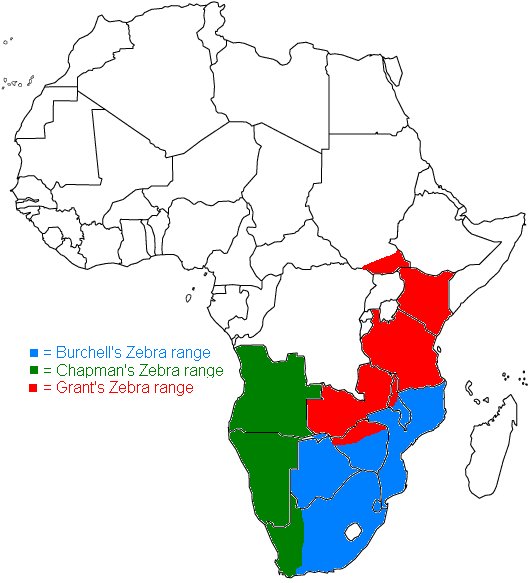
The Common Zebra is very common throughout southern and eastern Africa and often forms mixed herds with Wildebeest. It lives in herds of up to 100, although normally these herds would number 15-20. It is a grazing animal and prefers open plains but can be found in bush thickets, woodland, wetland and semi-desert.
Mountain Zebra
The Mountain Zebra has a smaller range than the Common Zebra and is harder to find in its upland habitat. Although they are named Mountain Zebras they are not really found on mountains, their preferred habitat is high-altitude plains and hills. There are two sub-species of Mountain Zebra, the Hartmann’s Mountain Zebra and the Cape Mountain Zebra.
Cape Mountain Zebra: western South Africa, Cape Province, northern Namibia.
Hartmann’s Mountain Zebra: southern Angola, Botswana, Zimbabwe, Northern South Africa, Swaziland and southern Mozambique.
Both sub-species are endangered although we were lucky enough to see them both on our holiday to South Africa in October 2004.
Grevy’s Zebra
Grevy’s Zebra are the largest and rarest of the three Zebra species. They have been over-hunted and persecuted for many years in east Africa. There are now as little as 3,000 remaining in the wild. They are a desert animal and are found in the scrub and aridlands of northern Kenya and southern Ethiopia. They used to be common in Somalia but became extinct there in 1973.
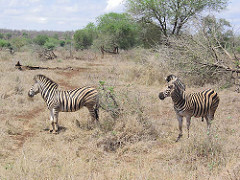
On Friday afternoon me, mum and clara came home to a rather unusual surprise. Rio (one of our two cats) had brought us a present, one we wouldn’t normally expect. Dad was at home and took the creature off Rio (that was still alive) and put it in a shoebox with some earth, water and a slug.
Both our cats kill, or attempt to kill lots of animals. Rio kills by far the most though. He brings home pretty much anything including mice, rats, squirrels and various birds including collared doves, woodpigeons, blackbirds and robins. He has also tried a hedgehog but failed. Sheeba tends to attack the smaller animals, all she’s ever killed is a spider although she often tries frogs and stag beetles! But this time Rio brought home a …………. Slow worm!
We had a look at it for a while before releasing it back into the garden, with the cats safely inside.
The black or hook lipped rhino is the smaller, more aggressive and rarer of the two species of African rhino, the black rhino and the white rhino. Black rhino are a critically endangered species and there are between 2,500 and 3,000 left in the wild. In the 1970s when poaching was most popular black rhinos were hunted to the very brink of extinction but now with armed patrols in many game reserves rhinos are making a steady recovery. Black rhinos breed well in captivity and being herbivores are easy to release into the wild. Unlike white rhino that live in small family groups of 3-4 the black rhino prefers to live a solitary life. Black rhinos are browsers and often use their 1.5 tonnes of weight to knock fruit down from trees. If black rhinos feel threatened by humans on foot they can charge at speeds of 30mph despite their massive weight. Black rhinos share the same habits of many other savannah animals like wallowing in mud and carrying oxpecker birds on their back to remove fleas and ticks. Rhinos drink once a day and sometimes use their horns and back legs to dig for water underground if water is scarce above the ground.
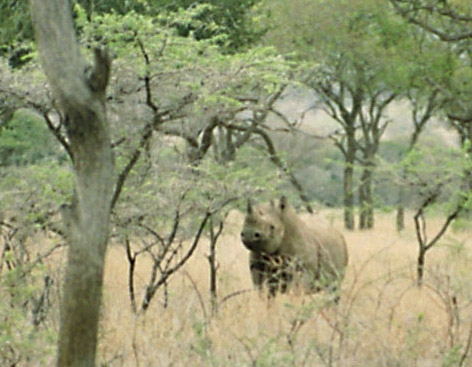
Black Rhino that mum and dad saw on their game walk in Mkuzi.
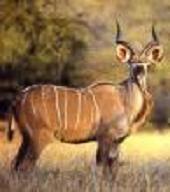 |
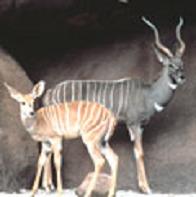 |
| Greater Kudu | Lesser Kudu |
There are two different types of Kudu, the Greater Kudu and the Lesser Kudu. The Greater Kudu is bigger than the lesser Kudu and have hair along their back and down the font of their throat. Another difference is that female Lesser Kudu are orange whilst Greater females are the same greyish colour as the males. Like most antelope the males have horns but the females don’t. Kudu are found in thick bush or forest where they can camouflage from Lions. They are more common in Southern Africa than East Africa because Southern Africa is bushier than East Africa. Small populations can also be found in the Kalahari Desert. Kudu live in family groups or small herds consisting of two or three families. As Greater Kudu are bigger then Lesser Kudu they have fewer predators. Lions and Crocodiles are the only natural predators of Greaters but Leopards may also hunt Lessers, particularly the females because they are smaller and easier to catch. Kudu have very good reactions and senses meaning they normally survive when Lions go after them. Poachers hunt Kudu for their horns, and the head, like many antelopes, is considered a valuable trophy. Because of this Kudu are classified as Lower Risk in their Conservation status.
Paul Smith is a goalkeeper who Southampton signed for ‘500,000 from Brentford in January 2004. He was signed on the last day of the January transfer window although a power cut nearly prevented the move! For a year he didn’t get a game for saints but in January Antti Niemi, the first choice goalkeeper, got injured and Paul Smith got a chance. He put in some decent performances before Niemi returned from injury. A few games later Niemi got injured once again. Smith got another chance and played superbly against Everton, West Brom, Arsenal and Tottenham. After this there was talk of possible England appearances. Now Niemi was back and Southampton manager Harry Redknapp had a dilemma. It was the big match in the Quarter finals of the F A Cup. Saints had been drawn against Manchester United. One of the favourites and the current holders of the Cup. Would he keep the in-form Smith or turn to the experienced and well regarded Niemi. He chose to keep Smith and saints lost rather disappointing 4 – 0. Smith was dropped for the next game against Middlesbrough but Niemi made a mistake in the first half spilling a simple shot and gifting Jimmy-Floyd Hasselbaink a tap-in. But later in the game he made some good saves and saints came out comfortable winners by three goals to one. Although a slightly sad ending for Smith he has built up a excellent reputation and with the ageing Niemi often getting injured Smith is sure to get more chances and is now expected to perform.
|
Olive Baboon |
Chacma Baboon |
|
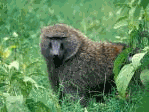
|
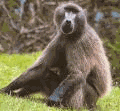
|
|
|
Animal Type |
Mammal – Primate |
Mammal – Primate |
|
Conservation Status |
Lower Risk |
Lower Risk |
|
Distribution |
Eastern Africa |
Southern Africa |
|
Habitat |
Savannah Scrub |
Savannah and City |
|
Predators |
Leopard, Lion, Cheetah and Crocodile |
Leopard, Lion, Cheetah and Crocodile |
|
Diet |
Fruit, Eggs, Fish, Monkeys and newborn antelope |
Fruit, Eggs, Fish, Monkeys and newborn antelope |
Baboons are social animals and live in large groups called troops. They are often seen with Impala because Baboon and Impala help each other keep safe by teaming up their senses. Despite this alliance Baboons will attempt to catch newborn Impala. Chacma Baboons are very tame. They are pests at the campsites in the wild and at the resorts and attractions in the city. Baboons will steal food from tourists. Baboons spend most of the day on the ground searching for food and playing with other members of the troop. In the night Baboons will go to their sleeping spot in the trees. Baboons have several sleeping spots around there territory and will sleep in the safest one. Chacma Baboons live for about 45 years whilst Olive Baboons live 30 ‘ 45 years.
The Cape or African Buffalo is a large mammal and the only type of cow adapted to the African savannah. Herds vary from 10 to about 2000 in areas such as the Okovango Delta where they are migratory. Buffalo do not really have any predators, Lions and Crocodiles will attack weak or old members of herds. Old bulls often leave herds to become solitary and they are the most often preyed upon. Buffalo can be dangerous and often stampede towards predators. Buffalo kill the young of their predators and many adult animals are also killed. Buffalo wallow to help keep cool and remove fleas. Buffalo are normally seen with oxpecker birds, Buffalo’s best friend, which also help remove fleas and ticks.
African Leopard
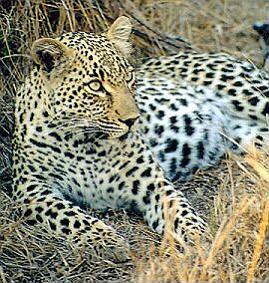
Where Leopards live
Animal Type: Mammal – Cat
No. In Wild: 500,000
Distribution: Most of Africa.
Habitat: Thick savannah bush, rainforest, highland areas. Is very adaptable.
Predators: Lions, Hyenas, Crocodiles and Humans.
Prey: Small to medium sized Antelope, Monkeys, Hares, Birds and small mammals. Has developed a taste for dog and often takes Jackals and occasionally may take a Wild Dog.
Despite the being 500,000 Leopards in Africa seeing a Leopard is amazingly hard. Leopards are among the most secretive animals in the world and are most active at night. They spend the day lying in thick areas of bush or in trees. Leopards enjoy Boabab, Umbrella Thorn Acacia and Fig trees.